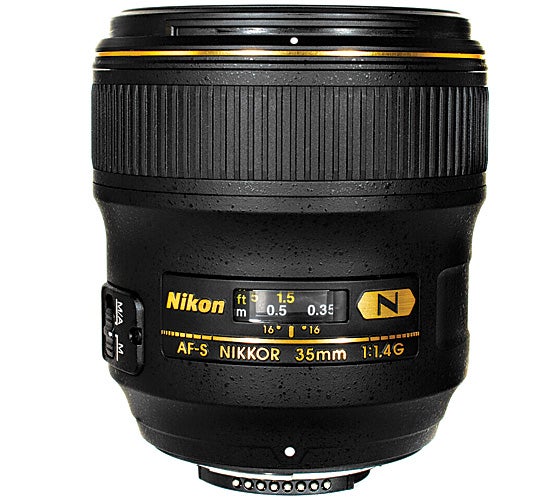Lens Test: Nikon 35mm f/1.4G ED
It's prime time for Nikon shooters

We may earn revenue from the products available on this page and participate in affiliate programs. Learn more ›
Last month we tested the industry’s least expensive 35mm f/1.4 lens (the $500 Rokinon 35mm AS UMC). This month, we shift to the opposite end of the pricing spectrum to one of the most expensive: Nikon’s $1,800 full-frame 35mm f/1.4G lens.
Like all f/1.4 primes, it’s large and heavy—more than three times the bulk of the 7-ounce 35mm f/2 Nikkor. Its weight is identical to last month’s Rokinon as well as Canon’s comparable 35mm f/1.4. This new Nikkor scales up to 52.5mm on DX bodies.
Because the lens is rear-focusing, the relatively large front element doesn’t turn. The result is much faster, smoother, and quieter AF than you might expect from so much glass. In fact, as with all Nikon’s SWM-driven focusing systems, its autofocus was rapid, sure, and near-soundless. The manual-focusing ring’s long 100-degree turning radius, however, made manual focus very pleasant.
This handsome lens is cosmetically mated to Nikon’s other top-drawer primes: matte-black barrel; a generously scaled, ribbed, rubber manual-focus collar; and gold-toned markings, including a depth-of-field scale (minimum aperture only) and thelarge N indicating Nikon’s Nano Crystal coating to shield against internal ghosting and flare.
On our test bench, the lens produced Excellent-range SQF sharpness numbers at all apertures up through the 11×14-inch enlargement size; all but f/16 were Excellent at 16×20. It edged out the Rokinon, and at maximum aperture was far sharper than the Average-performing Canon 35mm f/1.4 that was tested in these pages more than a decade ago.
Similarly, the Nikon’s Slight-range distortion control was marginally better than that of the manual-focus Rokinon, and significantly better than the Canon’s Visible-range barreling.
Like almost all high-speed primes, it delivered beautifully defocused backgrounds, a bright viewfinder image, and a sturdy build. It promises superb low-light interiors, wedding images, group portraits, and more.
But you have to ask yourself: Is the stop between Nikon’s f/1.4 and f/2 full-frame 35mm primes really worth an extra $1,400 and almost a pound in additional weight?
Well, if you’re a wedding photographer trying to edge out the competition with velvety defocused backgrounds and sharp brides under flickering candlelight, the answer is an immediate and unqualified yes.
SPECIFICATIONS:
35mm (35.91mm tested), f/1.4 (f/1.46 tested), 10 elements in 7 groups. Focusing turns 100 degrees.
Diagonal view angle: 63 degrees.
Weight: 1.40 lb.
